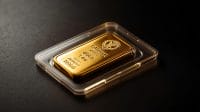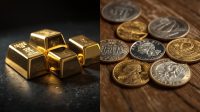
Bullion vs Numismatics
If you’re considering buying precious metals, you’ve likely heard the terms bullion vs numismatics. While both involve coins and bars made of gold, silver, platinum,
FREE fully insured shipping on all orders.
When you buy or sell gold and silver, you’ll quickly notice two numbers: the spot price and the premium. The spot price is the base market value of the metal, while the premium is the added cost you pay when buying (or receive less when selling). Understanding this difference is essential for smart bullion investing.
The spot price is the current market price for one ounce of gold or silver, traded on global exchanges like COMEX and LBMA. It reflects the live supply-and-demand dynamics, updated constantly as markets move.
Example: If the gold spot price is $3,000/oz, that’s the baseline value for one ounce of pure gold before dealer costs.
A premium is the extra cost above the spot price when buying bullion. It covers:
Example: If gold’s spot is $2,000/oz and a dealer lists a coin for $2,060, the $60 difference is the premium.
Many investors start with bullion for stability, then branch into numismatics as a hobby or long-term speculative play.
It’s a common mistake for new investors to assume they can buy at spot. In reality:
When selling bullion back to a dealer:
Veldt proudly serves customers across the United States with FREE insured nationwide shipping. We also welcome local clients at our San Diego office. If you’re nearby, you can meet with us in person to discuss your gold and silver investment strategy, pick up an order, or securely buy and sell precious metals for crypto.
Make an appointment to buy or sell gold and silver for crypto with us in Downtown San Diego.

If you’re considering buying precious metals, you’ve likely heard the terms bullion vs numismatics. While both involve coins and bars made of gold, silver, platinum,

An assay is the analysis used to test the purity and composition of a precious metal. In gold and silver, the assay ensures that coins

Precious metals are high-value items that attract theft if mishandled during transit. Whether you are buying from a dealer or selling to one, using secure

When people start buying precious metals, one of the first questions they ask is: Should I buy coins or bars? Understanding the differences between gold
|
Gold: 4,194.66 | Silver: 58.41 | Platinum: 1,663.13 | Palladium: 1,516.12 |